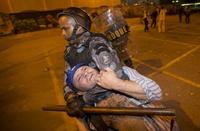-
Cloud computing poses technical challenges for digital crime-fighters
The ultimate in distributed computing, cloud computing is revolutionizing how digital data is stored, processed, and transmitted. It enables convenient, on-demand network access to a shared pool of configurable computing resources, including servers, storage, and applications. The characteristics that make this new technology so attractive also create challenges for forensic investigators who must track down evidence in the ever-changing, elastic, on-demand, self-provisioning cloud computing environments.
-
-
Pennsylvania cybersecurity group takes down international criminal network
Over the past month, a coalition of cybersecurity forces in Pittsburgh, Pennsylvania made of regional FBI officers and members of Carnegie Mellon University’s CERT cyberteam, took down the Gameover Zeus cyber theft network, which had employed data ransom and theft schemes. The criminal group was able to snatch funds up to seven figures from owners’ bank accounts.
-
-
Supreme Court: police must obtain a warrant to search suspect’s cellphone
Earlier this week the Supreme Courtruled that law enforcement must obtain a warrant to search a suspect’s cellphone. Law enforcement argued that no current law makes a distinction between cellphones and the pocket litter (wallets, cigarette packs) which police have always been permitted to search when arresting a suspect, but Chief Justice John Roberts rejected this argument, saying, “That is like saying a ride on horseback is materially indistinguishable from a flight to the moon,” adding: . “Modern cell phones, as a category, implicate privacy concerns far beyond those implicated by the search of a cigarette pack, a wallet or a purse.” Roberts acknowledged that requiring police to seek a warrant could impede some investigations but “privacy comes at a cost,” he said.
-
-
The real reason for a decline in violent crime

A scientific analysis of twenty million words recorded during 150 years of criminal trials at London’s Old Bailey reveals how changes in culture rather than law helped to reduce violent crime, according to a new study. “What we have been able demonstrate through analyzing the language used in court is that the decline in less serious forms of violence, such as assault, was not led by legislation or moments of dramatic change in the law, but by social attitudes,” says one of the authors.
-
-
World Cup security teams focus more on crime, protests – less on terrorism

During the 2014 FIFA World Cup, currently being held across twelve different venues across Brazil, security teams have extensively prepared for measures to be taken against crime and protest related to heated political unrest. American bomb-busting robots, Israeli surveillance drones, and German anti-aircraft tanks — an international assortment of security officials and measures – are just some of the pieces of the greater security apparatus protecting both players and fans.
-
-
A first: Armed robber convicted based on Chicago’s facial recognition technology
Pierre Martin became the first person in Chicago to receive a prison sentence after being convicted based on evidence from the city’s facial recognition technology, NeoFace. Martin was sentenced Monday to twenty-two years for two armed robberies carried out on the Chicago Transit Authority(CTA) train system in January and February 2013. A few weeks after the incidents, Chicago Police Department officials announced that Marin was identified using facial recognition software.
-
-
House passes measure requiring review of intelligence sharing practices
In the bill is the first legislation written in response to shortcomings revealed by the Boston marathon bombings,the House of Representatives last Friday approved a measure which requires the FBI, DHS, and the Office of the Director of National Intelligence to review their information sharing practices and report back to Congress within ninety days. Post-bombing investigation concluded that had intelligence agencies shared information on Tamerlan Tsarnaev, one of the suspects in the Boston Marathon bombings, prior to the incident, local law enforcement authorities may have been able to monitor Tsarnaev’s actions.
-
-
Hitting the reset button on Secure Communities
Last Tuesday law enforcement officials said they anticipate a “reboot” of the controversial immigration enforcement program, Secure Communities, in which police officers are asked to submit fingerprints taken by police to DHS so the individuals stopped by the police can be screened for deportation eligibility. Critics argue the program leads to too many low-level criminals and non-criminals being turned over to immigration authorities, and in addition to the cost involved in the process, the program could make witnesses and victims of crime reluctant to cooperate with law enforcement.
-
-
New technology tests ammo while saving joints
Firing and testing thousands of rounds of ammunition weekly can challenge the human body — even ones in top physical condition — causing debilitating stress injuries and chronic nerve and joint pain. DHS Science and Technology Directorate (S&T), with the help of agents from ICE Office of Firearms and Tactical Programs (OFTP) Armory Operations Branch (AOB), has taken an important step forward in reducing or eliminating these injuries by developing of the “Virtual Shooter.”
-
-
DOJ, NIST team up to shore up forensic science, but skeptics question effort
Five years ago, a report on the state of forensic science by the National Academy of Sciences decried the lack of sound science in the analysis of evidence in criminal cases across the country. It spurred a flurry of outrage and promises, but no immediate action. Now, renewed efforts are underway, with the Department of Justice (DOJ) and the National Institute of Standards & Technology (NIST) teaming up to create a National Commission on Forensic Science.
-
-
Forensic DNA technology could help identify abducted Nigerian girls
Forensic DNA technology developed in the aftermath of the 9/11 attacks could be used to identify and reunite more than 200 Nigerian girls who were kidnapped by Islamist militants, scientists said. The software, Mass Fatality Identification System (M-FISys), has been used worldwide — in Mexico, Guatemala, El Salvador, Honduras, Perú, Sri Lanka, the Philippines, Thailand, Malaysia, among several other countries — to identify and return more than 700 children who were abducted by criminals for child trafficking.
-
-
Sinn Féin’s president Gerry Adams arrested over 1972 murder
Sinn Féin president Gerry Adams was arrested on Wednesday for questioning about one of the most notorious IRA murders during the Troubles. Detectives in Antrim questioned Adams about the execution of Jean McConville, a widowed mother of 10 who was dragged from her west Belfast home in 1972, tortured, and shot in the back of the head. McConville was one of the “Disappeared” – IRA victims whose bodies were buried so they would never be found — and her body was not discovered until 2003. Adams’s arrest and questioning follows a ruling by a court in the United States which compelled Boston College to hand over to the Police Service of Northern Ireland recorded interviews with veteran IRA members about McConville’s murder.
-
-
U.S. should significantly reduce incarceration rate: study
There has been an unprecedented and internationally unique rise in U.S. state and federal prison populations, from 200,000 inmates in 1973 to 1.5 million in 2009. This increase occurred because of policy decisions such as mandatory sentencing, long sentences for violent and repeat offenses, and intensified criminalization of drug-related activity. Given the minimal impact of long prison sentences on crime prevention and the negative social consequences and burdensome financial costs of U.S. incarceration rates, which have more than quadrupled in the last four decades, the United States should revise current criminal justice policies to significantly reduce imprisonment rates, says a new report from the National Research Council. The dramatic rise in prison population “not serving the country well,” the report says.
-
-
Violence and corruption by drug cartels hits homeland
While the American media devotes much time and effort to pinpointing the violence and corruption generated by the drug cartels in Mexico, far less attention is devoted to crimes in this country which are a direct result of these same criminal organizations. The corruption of American law enforcement has become a significant problem along the border. The Mexican drug cartels which control drugs and human smuggling are directly responsible for a spiraling level of violence and crime which instills fear among residents on both sides of the border even as it lowers the quality of life for all who call the U.S.-Mexican borderlands their home.
-
-
Tiny particles could help verify goods

Chemical engineers hope smartphone-readable microparticles could crack down on counterfeiting. Some 2 to 5 percent of all international trade involves counterfeit goods, according to a 2013 United Nations report. These illicit products — which include electronics, automotive and aircraft parts, pharmaceuticals, and food — can pose safety risks and cost governments and private companies hundreds of billions of dollars annually. Researchers have invented a new type of tiny, smartphone-readable particle that they believe could be deployed to help authenticate currency, electronic parts, and luxury goods, among other products. The particles, which are invisible to the naked eye, contain colored stripes of nanocrystals that glow brightly when lit up with near-infrared light.
-
More headlines
The long view
Why Was Pacific Northwest Home to So Many Serial Killers?
Ted Bundy, Gary Ridgway, George Russell, Israel Keyes, and Robert Lee Yates were serial killers who grew up in the Pacific Northwest in the shadow of smelters which spewed plumes of lead, arsenic, and cadmium into the air. As a young man, Charles Manson spent ten years at a nearby prison, where lead has seeped into the soil. The idea of a correlation between early exposure to lead and higher crime rates is not new. Fraser doesn’t explicitly support the lead-crime hypothesis, but in a nimble, haunting narrative, she argues that the connections between an unfettered pollution and violent crime warrant scrutiny.
